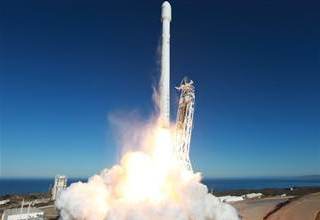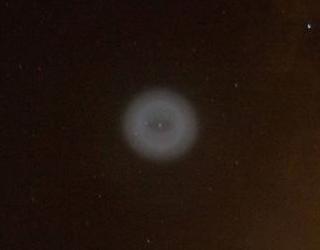After being confronted with a large number of objects via celestrak.com I saw T.S. Kelso his tweet on twitter where he is also trying to find out why there are so many object after the Falcon 9 v1.1 launch. “Trying to make sense of today’s Falcon 9 launch. There were supposed to be 6 payloads, but we have 20 objects (so far). TLEs are online.” Via Spacenews I found the following possible explanation for this.
 U.S. Space Surveillance Network is tracking a large number of objects after Falcon 9 v1.1 Launch.
U.S. Space Surveillance Network is tracking a large number of objects after Falcon 9 v1.1 Launch.
SpaceX issued a statement Oct. 1 denying speculation that the upper stage of its Falcon 9 v1.1. rocket exploded on orbit following the rocket’s successful demonstration launch Sept. 29 from the Vandenberg Air Force Base in California.
The speculation was spawned in part by the fact that the U.S. Space Surveillance Network is currently tracking more orbital objects associated with the launch than expected.
“Regarding the rumors you may have heard about the Falcon 9 second stage, in short, our data confirms there was no rupture of any kind on the second stage,” SpaceX spokeswoman Emily Shanklin wrote in an Oct. 1 email. “Following separation of the satellites to their correct orbit, the Falcon 9 second stage underwent a controlled venting of propellants … and the stage was successfully safed. During this process, it is possible insulation came off the fuel dome on the second stage and is the source of what some observers incorrectly interpreted as a rupture in the second stage.”
SpaceX attempted to reignite the upper stage after payload separation in a demonstration of a capability it will need to place satellites into the proper geostationary transfer orbit. However, the re-ignition sequence was aborted after a problem was detected, SpaceX Chief Executive Elon Musk told reporters in a post-launch teleconference.
 Following the launch, an eyewitness in Reunion Island off the eastern coast of Madagascar posted a photograph on the website Reddit of what amateur astronomers later determined was a cloud of rocket propellent surrounding the spent Falcon 9 1.1 upper stage. By Sept. 30, the U.S Air Force-run Space Surveillance System was tracking 20 objects associated with the launch in low Earth orbit. Experts were expecting to see 11 objects, including Cassiope; the three secondary payloads, one of which released seven independently flying objects; and the upper stage.
Following the launch, an eyewitness in Reunion Island off the eastern coast of Madagascar posted a photograph on the website Reddit of what amateur astronomers later determined was a cloud of rocket propellent surrounding the spent Falcon 9 1.1 upper stage. By Sept. 30, the U.S Air Force-run Space Surveillance System was tracking 20 objects associated with the launch in low Earth orbit. Experts were expecting to see 11 objects, including Cassiope; the three secondary payloads, one of which released seven independently flying objects; and the upper stage.
SpaceX’s explanation of events is copied below:
Following separation of the satellites to their correct orbit, the Falcon 9 second stage underwent a controlled venting of propellants (fuel and pressure were released from the tank) and the stage was successfully safed. During this process, it is possible insulation came off the fuel dome on the second stage and is the source of what some observers incorrectly interpreted as a rupture in the second stage. This material would be in several pieces and be reflective in the Space Track radar. It is also possible the debris came from the student satellite separation mechanisms onboard. SpaceX will continue to review to help identify the source of the extra debris, but our data confirms there was no rupture of any kind on the second stage.
Source: Spacenews

Falcon 9 Explosion – Update (7th October 2013)
AS of October 7, SpaceTrack had provided element sets for twenty objects. All of which had their first data issued shortly after the September 29 launch. Ten of them only appeared once or twice during the first 24 hours and are no longer being updated, the remainder have received updated sets during the week that has followed since.
Of the updated items, two are exhibiting rapid orbital decay and will probably have re-entered by the time this article appears. Another three are decaying nearly as quickly but will probably last about another week before re-entry (the missing ten may have decayed too quickly for Space Command to find them a second time). The other five are maintaining their orbits but the spread of data on three of them indicates that tracking sensors do not have a particularly good ‘lock’ on them.
At the start, they showed a scatter in apogee between 1350 and 1654 km and in perigee between 235 and 415 km. Inclinations varied between 80°.94 and 81°.04. Obviously, with the rapid orbital decay rates of some, the spread is now significantly greater.
Falcon 9
SpaceTrack has catalogued 2013-055G/39271 as the Falcon 9 rocket body and latest data show it in an orbit of 319 x 1489 km, 81°.0 inclination, very close to the 325 x 1500 km, 81° target orbit issued by SpaceX prior to launch.
The Payloads
The Catalogue does not yet contain separate identities for the payloads and, most unusually, they are not represented individually by any of the highly-scattered objects listed so far! There are more Objects to come.
SpaceTrack has issued Radar Cross Section measurements for all the fragments. Most values indicate that the objects are quite small with current values generally less than 1. They will change with time as the tracking systems get more readings.
There is a single, very obvious exception (2013-055B/39266) currently shown in an orbit having parameters within 1 km of the rocket body. Its RCS value is a massive 42.
At the moment, it seems to be a single entity that represents the payloads and their support equipment as one object. They are so close together that Space Command is not yet prepared to pass individual orbital datasets to SpaceTrack for publication. One thought process says that maybe they are too close together for them to be distinguished by tracking sensors. An alternative reason might be that the US military does not want to reveal precisely how good its sensors are. Either way we have to wait for Spacetrack to publish element sets before we see actual orbits for the individual satellites.
Or do we…….
In the Seesat-L discussion forum, amateur satellite observer Greg Roberts of South Africa is providing a steady stream of observations that show the six individual payloads and just how close together they are.
The Fragments
The scattered nature of the objects catalogued so far indicates that they have arrived in their individual orbits as the result of an explosive event. Whether by it was a conventional explosion or caused by rupture of a pressurised object can probably only be answered by SpaceX, the rocket manufacturer, because the Falcon 9 is highly likely to be the culprit. Of the debris, most of it is in orbits with a lower inclination than the Falcon 9 upper stage indicating that it was blasted sideways. The up and down distribution would have been caused by the debris spreading in a fan of sideways directions as it was ejected.
The Falcon 9 was to have executed a sideways manoeuvre after it released the payloads but the rocket firing was aborted. SpaceX says simply that the rocket motor ceased its ignition routine when the chamber pressure reached 400 pounds per square inch (apologies for the units). Combined with the evidence of an the orbital debris, it leads to the question of whether there was an explosive loss of pressure. SpaceX’s next customer is slightly worried by events.
SpaceX
After the original zary.info Blog entry was published, the SpacePolicyOnline.com website asked a question of SpaceX concerning the possible explosion. The response was “….Following separation of the satellites to their correct orbit, the Falcon 9 second stage underwent a controlled venting of propellants (fuel and pressure were released from the tank) and the stage was successfully safed. During this process, it is possible insulation came off the fuel dome on the second stage and is the source of what some observers incorrectly interpreted as a rupture in the second stage. This material would be in several pieces and be reflective in the Space Track radar. It is also possible the debris came from the student satellite separation mechanisms onboard…..”
If this were true then the “insulation material” would initially in a similar orbit to the rocket but the orbits would decay rapidly because of the low density of the material. The statement makes no reference to the failed rocket ignition as a possible factor and given the closely bunched nature of the payload orbits, their separation mechanisms are probably still to be catalogued and are not likely to be among the debris.
Some of the material is in rapidly decaying orbits but the starting point was a spread of orbit heights averaging 100km either side of the rocket, indicating that they were blasted away at up to 50 metres per second – not exactly a gentle separation. Four items are in relatively stable orbits indicating something more dense, maybe pieces of dense plastic, metal or ceramic.
Source: Zarya